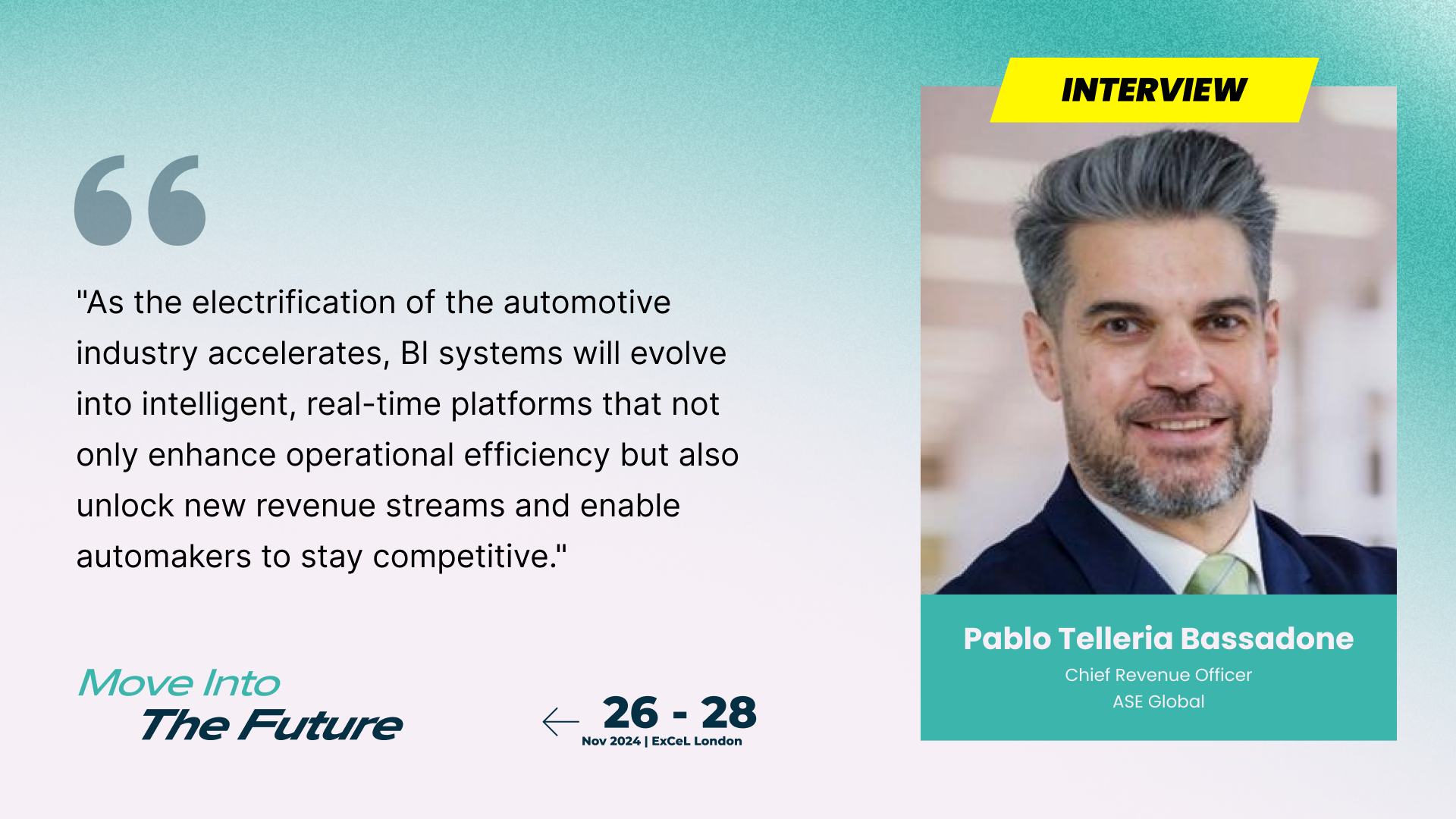We are delighted to present a Q&A session with Pablo Telleria Bassadone, Chief Revenue Officer at ASE Global. With over 20 years of experience in strategic consulting and business intelligence (BI) systems, Pablo has led growth initiatives for OEMs, NSCs, and dealerships across Europe, China, India, and APAC. An Industrial Engineer with an MBA and the HPL certification from IMD, he brings deep expertise in aligning strategy with industry trends.
In this Q&A, Pablo offers insights on the future of mobility, electrification, and how BI systems are evolving to meet EV market demands. He also discusses ASE Global’s approach to helping clients navigate new business models and optimise profitability.
#LEVS: With your extensive experience in transforming business models within the global auto and mobility industry, how do you see the role of business intelligence systems evolving to meet the needs of an increasingly electrified vehicle market?
#Mr Pablo: The evolution of business intelligence (BI) systems not only in the ICE vehicles, but also in the EV market is critical as the automotive industry undergoes a profound transformation. With the rise of electric vehicles, there are several emerging trends and challenges that BI systems will play a crucial role in addressing.
BI systems will need to process and analyse vast amounts of data, ranging from vehicle performance, customer preferences, energy consumption, supply chain dynamics, and charging infrastructure usage. This will be critical in optimizing operations across the entire value chain of EVs, integrating data from various stakeholders—manufacturers, battery suppliers, utilities, and charging station operators—to provide a holistic view of market trends and operational efficiency.
As we all know, EVs are tightly linked with energy consumption, BI systems will evolve to provide insights into energy usage, demand forecasting, and grid management. BI tools will aid in optimising the lifecycle of EV batteries, from manufacturing to recycling, a key concern for sustainability.
The customer experience for EVs is different compared to ICEs vehicles, with factors like range anxiety, charging preferences, and environmental concerns playing a larger role. Cars are evolving to “computers on wheels” with a lot of software that helps manage how the vehicle functions. BI systems will leverage data from in-vehicle sensors, customer apps, and charging networks to offer highly personalised services.
As vehicles become more connected, BI systems will need to handle not just the vehicle data but also integrate with smart cities, IoT infrastructure, and even renewable energy grids. This convergence of mobility, energy, and data will be central to the EV ecosystem
As traditional automaker revenue streams shift from vehicle sales to new models like mobility-as-a-service (MaaS) and energy services, BI systems will play a critical role in identifying profitable new opportunities and new business models.
As the electrification of the automotive industry accelerates, BI systems will evolve into intelligent, real-time platforms that not only enhance operational efficiency but also unlock new revenue streams and enable automakers to stay competitive.
#LEVS: As ASE Global focuses on driving profitability and operational performance in the automotive sector, what key strategies would you recommend for OEMs and dealer networks to successfully navigate the shift towards electric vehicles?
#Mr Pablo: ASE works closely with renowned automotive brands and their dealer networks to enhance profitability, manage business risks, and improve operational performance.
For OEMs (Original Equipment Manufacturers) and dealer networks to successfully navigate the shift towards electric vehicles (EVs), several key strategies should be adopted to ensure profitability and sustained operational performance.
OEMs and dealer networks must invest in building or partnering with robust charging infrastructure networks. This includes installing charging stations at dealership locations, providing home-charging solutions, and forging partnerships with public charging providers. Offering a seamless charging experience will not only improve customer satisfaction but also strengthen brand loyalty and bring new revenue streams.
Dealer networks must shift their traditional sales and service models to accommodate the unique requirements of EVs. Electric Vehicles come with a different value proposition, including lower long-term maintenance costs, fuel savings, and environmental benefits. Sales teams must be well-versed in conveying these points to customers.
From the aftersales point of view, EVs have fewer moving parts and require less regular maintenance than internal combustion engine (ICE) vehicles. Dealers should offer bundled services such as battery health checks, software upgrades, and charging support to maintain a consistent revenue stream from after-sales services.
Both OEMs and dealer networks need to invest in training their workforce to handle the specific requirements of EVs, including servicing electric drivetrains, managing high-voltage systems, and understanding software diagnostics. Creating a skilled and certified workforce ensures high-quality service delivery and customer satisfaction.
As customers move away from traditional car ownership models, OEMs and dealers can explore subscription-based services for EVs, where customers pay for use rather than ownership. This can also extend to offering bundled services like vehicle maintenance, insurance, and charging access. OEMs can further explore partnerships in the Mobility-as-a-Service (MaaS) space by providing EV fleets for ride-hailing or car-sharing services. Again, exploring these new business models can bring new revenues that can improve the performance of the dealerships.
As a summary, OEMs and dealer networks can stay ahead of the EV curve while maintaining profitability and operational performance. As the industry shifts, agility and foresight in adapting sales models, supply chains, workforce skills, and customer engagement will be critical. ASE Global's expertise in operational performance can further enhance these efforts by identifying efficiency gaps and optimising profitability during this pivotal transformation.
#Mr Pablo: Given your expertise in strategic consulting across diverse regions, how do you tailor electrification strategies for different markets such as Europe, China, and India, considering their unique regulatory and consumer landscapes?
#Mr Pablo: When tailoring electrification strategies for different markets like Europe, China, and India, it's essential to account for the distinct regulatory environments, consumer behaviours, infrastructure readiness, and market dynamics in each region.
Europe is Sustainability-Driven and with high regulatory pressure like emissions regulations like the EU Green Deal and the CO2 emissions standard for vehicles. As an example, many countries have set clear deadlines for phasing out internal combustion engine (ICE) vehicles, with some targeting 2030 for a full transition to electric vehicles (EVs).
European consumers are highly conscious of environmental issues, which drives demand for sustainable and premium EVs.
The EV charging infrastructure in Europe varies between countries. is more developed compared to other regions, but still is not enough for the EV car parc in EU, with some exceptions in some more EV developed countries
The case of China is more Government-Driven Electrification with Focus on Scaling China has aggressive policies to promote EV adoption, such as subsidies for EV manufacturers, EV production quotas (New Energy Vehicle credits), and restrictions on ICE vehicles. The government’s “Made in China 2025” plan positions China as a global leader in EV manufacturing.
China is a price-sensitive country with strong demand for affordable EVs from the mass market, though there’s also growing interest in premium EVs in cities. Because of this, there’s a strong emphasis on domestic brands, though foreign brands like Tesla are gaining traction.
From the point of view of charging infrastructure China is rapidly expanding, especially in urban centres, but rural areas remain underdeveloped. There is a strong government incentive for manufacturers and buyers to accelerate market penetration.
India is still an early-Stage Market with Focus on Affordability. India has an ambitious plan for electrification, with targets like having 30% of vehicles be electric by 2030. However, regulations are not as stringent as in Europe or China.
The FAME (Faster Adoption and Manufacturing of Hybrid and EVs) II scheme provides incentives, but the market is still in its nascent stage.
Like China, India’s market is highly price-sensitive, with demand focused on affordable, compact vehicles. There is a range anxiety and it is one of the major concerns due to underdeveloped charging infrastructure, which still is not developed.
Each market requires a balance of global technological innovations adapted to local regulations, consumer behaviour, and infrastructure needs, allowing companies to optimise EV strategies for both short-term growth and long-term sustainability.
#Mr Pablo: How is ASE Global preparing its clients for the future of mobility, particularly in terms of electrification readiness and the integration of new technologies into traditional automotive business models?
#Mr Pablo: ASE Global is focused on helping automotive clients navigate the rapidly evolving landscape of electrification and future mobility by providing strategic support for operational performance and profitability in Electrification and new mobility business models
ASE leverages data analytics to provide insights on the profitability of EV lines, helping clients adjust their operational models to reduce costs and maximise returns on new EV investments.
ASE Global helps dealerships and OEMs adapt to the new demands of EV infrastructure, by offering strategic advice on how dealerships can remain profitable in an EV-dominated future, given the potential decline in revenue from after sales services due to lower maintenance requirements for EVs.
One important thing that is required is training and skill development for Dealerships. In this sense, ASE supports the upskilling of dealership staff to ensure they are knowledgeable about EVs and capable of providing expert service and how it impacts performance and profitability. This includes helping dealerships to transition from focusing on internal combustion engines to understanding the nuances of EVs and hybrid technology.
ASE Global leverages its extensive automotive performance benchmarking tools to help businesses track their readiness and progress in the transition to electrification. This includes evaluating how efficiently a company is managing its EV sales, charging infrastructure, and customer service in comparison to industry standards.
ASE’s benchmarking services are key in helping automotive companies identify gaps in their current strategies and make data-backed adjustments to improve their performance in a future where EVs dominate the market.
ASE Global provides clients with financial consulting to manage the cost implications of electrification. This includes planning for the upfront investments needed for EV production lines, managing cash flow impacts due to changing revenue streams, and identifying opportunities for government incentives or cost-sharing with infrastructure partners.
#LEVS: How do global events like the London EV Show contribute to advancing the automotive industry’s shift towards electrification, particularly in terms of fostering innovation and collaboration among international stakeholders?
#Mr Pablo: Global events like the London EV Show play a pivotal role in advancing the automotive industry's shift toward electrification by fostering innovation, facilitating collaboration among international stakeholders, and driving global awareness around sustainable mobility.
The London EV Show provides a platform for automakers, technology providers, and startups to showcase their latest EV models, battery technologies, charging solutions, and other innovations. It gives visibility to advancements in battery efficiency, vehicle design, and autonomous driving features that are key to the future of mobility.
The event brings together diverse stakeholders from across the EV ecosystem, including automakers, component suppliers, technology firms, infrastructure providers, regulators, and investors. This global networking fosters cross-industry collaboration, which is essential for overcoming challenges in the electrification process. Through these events, the industry moves forward more cohesively toward a sustainable, electrified future.


